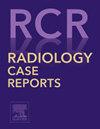Urothelial carcinoma mimicking Bosniak IV cystic mass: A case report
Q4 Medicine
引用次数: 0
Abstract
Urothelial carcinoma is the primary malignancy of the urothelium that has varying radiographic features based on the location of the tumor. Differentiating urothelial carcinoma from renal cell carcinoma is critical as interventions and management methods differ. We present a case of urothelial carcinoma within the calyceal diverticula that was initially suspected to represent Bosniak IV cyst due to cystic renal cell carcinoma. A 71-year-old male with a history of gross hematuria and a previously identified Bosniak II renal cyst underwent further imaging, revealing a Bosniak IV cystic mass with enhancing nodules. Subsequent nephrectomy unveiled noninvasive low-grade papillary urothelial carcinoma within a calyceal diverticulum. This case highlights the complexity of diagnosing urothelial carcinoma within the calyceal diverticula, emphasizing the need for a high index of suspicion. The study contributes to understanding the limitations of imaging modalities, especially in cases involving calcification or stone evaluation. The coexistence of urothelial carcinoma and calyceal diverticula is rare but crucial for accurate diagnosis and treatment. Documenting cases like these is vital for recognizing urothelial carcinoma mimics and ensuring appropriate patient management. The study underscores the significance of distinguishing features of calyceal diverticula and advocates for comprehensive imaging approaches in renal cystic lesions.
尿路上皮癌样波士尼亚克IV型囊性肿块1例
尿路上皮癌是尿路上皮的原发性恶性肿瘤,根据肿瘤的位置有不同的放射学特征。由于干预和治疗方法不同,鉴别尿路上皮癌与肾细胞癌至关重要。我们报告一例肾盏憩室内的尿路上皮癌,最初被怀疑为囊性肾细胞癌所致的波什尼亚克IV型囊肿。71岁男性,有肉眼血尿病史,既往确诊为Bosniak II型肾囊肿,进一步影像学检查显示为Bosniak IV型囊性肿块伴强化结节。随后的肾切除术发现肾盏憩室内无创低级别乳头状尿路上皮癌。本病例强调了诊断肾盏憩室内尿路上皮癌的复杂性,强调了高度怀疑的必要性。该研究有助于理解成像方式的局限性,特别是在涉及钙化或结石评估的情况下。尿路上皮癌和肾盏憩室共存是罕见的,但对准确的诊断和治疗至关重要。记录像这样的病例对于识别尿路上皮癌模拟和确保适当的患者管理至关重要。本研究强调区分肾盏憩室特征的重要性,提倡在肾囊性病变中采用综合成像方法。
本文章由计算机程序翻译,如有差异,请以英文原文为准。
求助全文
约1分钟内获得全文
求助全文
来源期刊

Radiology Case Reports
Medicine-Radiology, Nuclear Medicine and Imaging
CiteScore
1.10
自引率
0.00%
发文量
1074
审稿时长
30 days
期刊介绍:
The content of this journal is exclusively case reports that feature diagnostic imaging. Categories in which case reports can be placed include the musculoskeletal system, spine, central nervous system, head and neck, cardiovascular, chest, gastrointestinal, genitourinary, multisystem, pediatric, emergency, women''s imaging, oncologic, normal variants, medical devices, foreign bodies, interventional radiology, nuclear medicine, molecular imaging, ultrasonography, imaging artifacts, forensic, anthropological, and medical-legal. Articles must be well-documented and include a review of the appropriate literature.
 求助内容:
求助内容: 应助结果提醒方式:
应助结果提醒方式:


